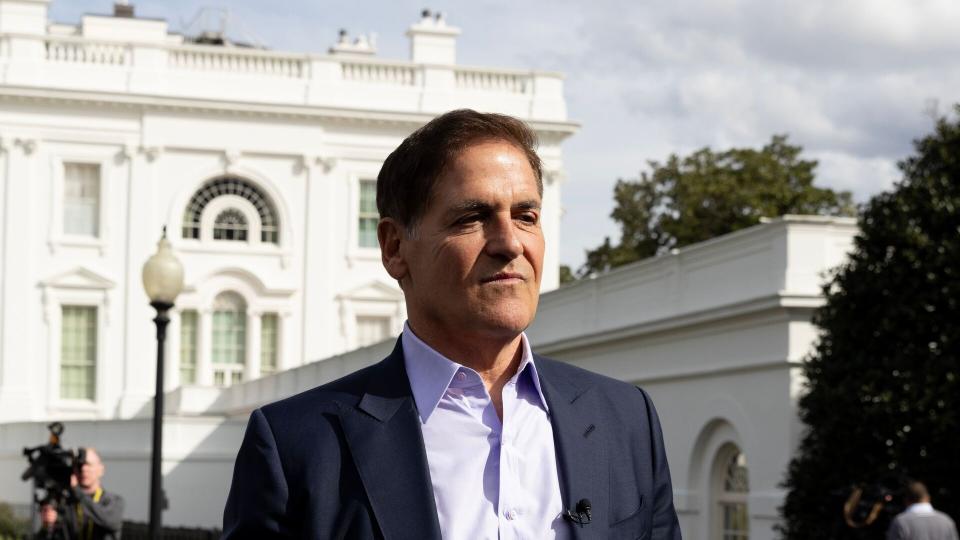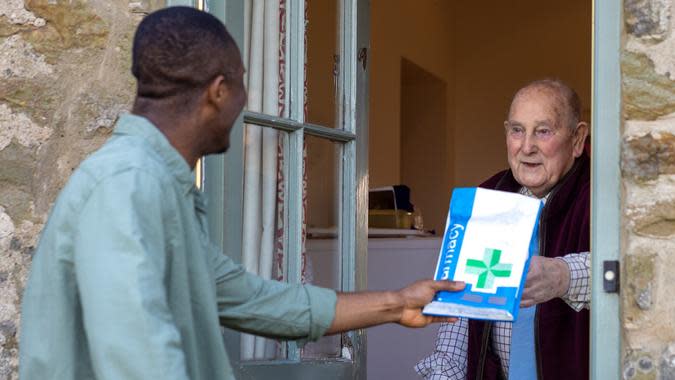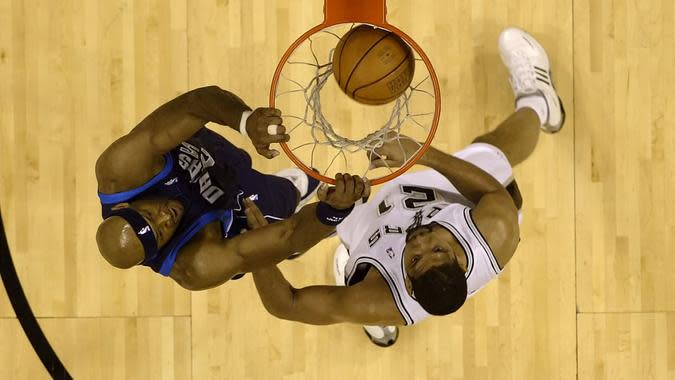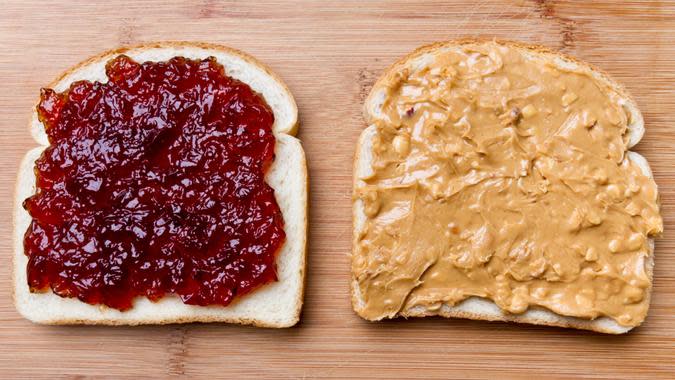Mark Cuban’s Money Timeline: See the Billionaire’s Financial Milestones Through His Career

From selling garbage bags door to door as a young boy to becoming a billionaire tech mogul and NBA team owner, Mark Cuban’s financial history is, simply put, extraordinary. Known for his keen business acumen, relentless work ethic and flair for spotting profitable trends as they’re emerging, Cuban’s career is a tableau of innovation, determination and strategic investment.
Read Next: I Followed Mark Cuban’s Genius Advice and Am on Track To Become a Millionaire
Check Out: 4 Genius Things All Wealthy People Do With Their Money
Here’s a look at the significant financial milestones in Cuban’s life, including pivotal moments and decisions that shaped his path to the immense wealth and popularity he enjoys today.

The World’s First Door-to-Door Garbage Bag Subscription Company: 1970
Cuban developed his entrepreneurial outlook at an early age. In an interview with GQ, he explained his first business opportunity: what he called “the world’s first, probably only, garbage bag door-to-door subscription company,” which he started when he was 12 years old.
A family friend sold Cuban boxes of new, unused trash bags for $3 each. Cuban would then resell them door-to-door in his neighborhood for $6. He developed a short but sweet sales pitch — 14 seconds — for his potential customers.
After his neighbors would answer the knock on their doors, he would launch right into it: “Hi, my name is Mark. Do you use garbage bags? I’ve got a great deal for you, and every time you need garbage bags, all you ever have to do is call me, and I’ll put ’em in the back of my wagon, and I’ll bring ’em right down to your house.”
Cuban grasped the importance of a simple, concise sales pitch, which gave him just enough time to communicate the value of the service he was offering. It’s a solid approach to business pitches, whether you’re selling $6 trash bags or $2 billion basketball teams.
Learn More: I’m a Self-Made Millionaire: Here’s the Lightbulb Moment that Helped Me Make My First Million
Find Out: Dave Ramsey’s Best Passive Income Ideas for 2024 — 15 ‘Steady, Profitable’ Ways To Build Wealth Fast
Wealthy people know the best money secrets. Learn how to copy them.

Early Hustle: Late 1970s to Early 1980s
As a student at Indiana University in the late 1970s, Cuban earned $25 an hour — over $108 an hour today — doing what he called “the best job ever”: giving sorority students disco dancing lessons. “Are you kidding me?” he said on the “The Jim Rome Podcast.” “I’d take that job now.”
The side gig and other part-time hustles helped Cuban stockpile enough capital to get into business after he graduated in 1981. He and a friend partnered in opening a bar, which turned out to be a responsibility the young college grad may not have been ready for. Cuban’s stint as part-owner was cut short when the bar was closed due to underage drinking violations, as reported by CNBC Make It.
With just $60 in his pocket, he moved to Austin, Texas, where he stayed with some friends. He capitalized on his bartending skills by landing a job at a local drinking hole and selling software to make ends meet.
For You: Tony Robbins: 10 Passive Income Ideas To Build Your Fortune

From Bartending to Bits and Bytes: 1989
Selling software in the early 1980s was a hot trend — and a smart move. Cuban is known today for his no-nonsense, detail-oriented approach to business and knack for spotting timely opportunities, reflecting some of the lessons he learned in his late teens and early 20s.
In 1989, Cuban co-founded MicroSolutions, a computer consulting firm. A year later, he sold the company to the now-defunct CompuServe for $6 million — roughly $11.4 million today — netting him around $2 million after taxes. This marked his first significant financial win — and the advent of his millionaire status.

Broadcast Billionaire: 1995
Cuban capitalized on his experience in the tech sector and the burgeoning internet industry by co-founding Broadcast.com with Todd Wagner, a former colleague from Indiana University, in 1995. Part Spotify and part YouTube, Broadcast.com was a pioneering audio and video streaming service that soon came to dominate the nascent internet content delivery industry.
Cuban and Wagner sold Broadcast.com to Yahoo for a staggering $5.7 billion only four years later, in 1999. Within a decade of making his first million, Cuban became a billionaire.

Nothing but Net: 2000
Cuban purchased a majority stake in the NBA’s Dallas Mavericks for $285 million in 2000. It was a smart investment fueled by his passion for basketball and profitable business ventures.
How profitable? Twenty-three years after the purchase, Cuban sold his controlling interest — a 58% stake — in the Mavs for an estimated $3.5 billion.
Discover More: 10 Valuable Stocks That Could Be the Next Apple or Amazon

A Landmark Move: 2003
Cuban and Wagner went on to combine their interest and experience in technology and entertainment by acquiring the Landmark Theatres chain in 2003. Under Cuban’s direction, Landmark became the biggest independent and art house movie theater chain in the U.S. and fundamentally changed moviegoers’ expectations.
If you’ve ever watched a movie from a sofa or recliner or eaten a meal before or after the show in a restaurant that shared an entrance with a theater, you may have Cuban to thank for those innovations.
“The original design had the traditional concession stand taking up prime real estate and dominating the look and feel of the theater,” Cuban told Variety.
He and Wagner instead focused on a “date night for grownups” concept by adding convenience and variety, like retail sales, partnerships with restaurants and other amenities that would appeal to changing tastes and expectations.
It worked, and the Landmark Theatres chain was eventually sold to Cohen Media Group in 2018. At the time of the sale, Landmark had 52 theaters with a combined total of 252 screens, including luxury theaters in prime locations in Los Angeles and Manhattan. Though the exact financial details of the sale were never publicly disclosed, Netflix and Amazon were reportedly among the potential buyers, so you can imagine the final dollar amount was significant.

Back to the Movies: 2003
Cuban’s interest in independent cinema didn’t stop with Landmark Theatres. The same year he and Wagner invested in the movie chain, the pair also acquired Magnolia Pictures, which has been the premier distributor of independent films for almost two decades.
Magnolia’s most recent successes include Ruben Östlund’s 2017 film “The Square” and 2018’s “Shoplifters” by Hirokazu Kore-Eda, both nominated for Oscars and winners of the coveted Cannes Palme d’Or.
Of course, prestige isn’t the same as profit — but Cuban’s a savvy investor, and Magnolia’s annual revenue is $1.8 million, according to Zippia.

Downstream, With a Paddle: 2012
You may not think a stand-up paddleboard startup would be a good business investment, but you’re not Mark Cuban. In 2012, through his work on “Shark Tank,” Cuban put $150,000 in what he would later call one of his favorite investments. That initial investment bought him a 30% stake in Tower Paddle Boards, founded just two years earlier as a direct-to-consumer paddleboard company.
Tower founder Stephan Aarstol acknowledged that he used most of that initial stake to pay off a $100,000 loan he had taken out to fund the company. Aarstol’s appearance on the third season of the show — and Cuban’s investment — spurred massive public interest in the company, which was swamped with $60,000 in orders following the initial broadcast, $50,000 of which went straight to Cuban as a dividend check.
Cuban continued to invest in the company, staking an additional $300,000 in 2013, helping Tower become the fastest-growing privately owned company in San Diego and securing the No. 239 spot on Inc.’s list of the 500 fastest-growing American companies just a year later. Tower has since branched out into a beach lifestyle brand, continues to pay Cuban dividends and is one of the strongest positions in his portfolio.
Try This: 8 Ways To Make $200 (or More) a Day Working From Home

Billionaire Insurance Salesman: 2012
By 2012, Cuban had become a household name due to his work on “Shark Tank.” That fame resulted in a lot of pitches that didn’t appear on the show, including one from a 25-year-old insurance comparison startup founder named Adam Lyons. Lyons somehow acquired Cuban’s private email address and sent a message containing his initial pitch with a simple subject line: “Wanna disrupt the insurance industry?”
It piqued Cuban’s interest, and he responded quickly, leading to a weekslong email exchange in which the pair finalized the details and Lyons secured Cuban’s investment. Though the amount of Cuban’s initial stake wasn’t disclosed, it has likely paid for itself many times over, as Lyons’ company, the Zebra, has been valued at more than $1 billion.

More ‘n’ More Profit: 2013
Cuban has been known for capitalizing on emerging trends, such as his 2013 investment in healthy snack food company Nuts ‘N More. The company markets various nut butter spreads.
“I’m always looking for foods that solve my sweet tooth and are healthy,” Cuban told Yahoo Finance. “This company fit that bill perfectly.”
The company has since seen its annual revenue grow to more than $6 million a year.

Back to the Bar: 2014
When Beatbox Beverages first appeared on “Shark Tank” in 2014, Cuban may have had some reason to feel a little nostalgic for his days as a bartender. In an interview with “Us Weekly,” he described the company’s founders as “just a bunch of partying guys and one girl out of Austin” and said his initial reaction was “OK, it’ll be fun.”
The group was marketing an alcoholic spritzer beverage, and the concept and the group’s enthusiasm inspired Cuban to invest a cool million for a 33% share of the company. The investment paid off: “Now they’re worth over $200 million. They’ll do, hopefully, $100 million in sales this year. And they’re just killing it.”
Explore More: Here’s How Much a $1,000 Investment in Ford Stock 10 Years Ago Would Be Worth Today

Prep for Profit: 2016
Entrepreneur Shaan Patal appeared on a Season 7 “Shark Tank” episode, pitching an SAT and ACT preparation solution called Prep Expert.
“The Dallas Morning News” reported that Patal reflected, “It went horribly for the first hour and 15 minutes,” with most of the show’s investors declining to make significant or committed offers. “But at the last second, Mark Cuban came and saved the day.”
Cuban’s initial investment was $200,000 for a 20% stake, and the company’s revenue has grown from $1.2 million over the four years prior to the deal to over $5 million in annual revenue.

From Profit to Philanthropy: 2022
In recent years, Cuban, like many billionaire entrepreneurs, has turned his focus from strictly money-making ventures to more philanthropic pursuits. His latest venture, the Cost Plus Drug Company, is doing nothing short of revolutionizing the pricing of generic pharmaceutical drugs.
Late last year, the company nearly doubled the number of medications it makes available directly to patients. It added 1,000 new medicines to its list, bringing the total to 2,200 drugs. All drugs sold through the company are available at cost, plus a publicly disclosed markup of 15% and a combined total of $10 in pharmacy and shipping fees.
While Cost Plus states, “everyone should be able to afford their medicine,” traditional pharmacies are typically focused more on profits than providing affordable medication. Conventional pharmacies are also much less transparent, basing the pricing of the drugs they offer on non-disclosed information.
Cuban said that he firmly believes that transparency and affordability should be fundamental practices in healthcare, and his approach with the Cost Plus Drug Company reflects that. By eliminating middlemen and hidden costs, the company makes sure that patients pay a fair price for their medications, which is a stark contrast and welcome relief from traditional pricing models.
By leveraging a business model that prioritizes transparency and direct-to-consumer sales, Cuban’s most recent venture will likely continue challenging the status quo and actively advocating for a future in which affordable healthcare is accessible to everyone.
More From GOBankingRates
9 Things You Must Buy at Big Lots While on a Retirement Budget
I'm a Mechanic: These 4 Cars Have Engines That Could Die on You
This article originally appeared on GOBankingRates.com: Mark Cuban’s Money Timeline: See the Billionaire’s Financial Milestones Through His Career

 Yahoo Finance
Yahoo Finance 